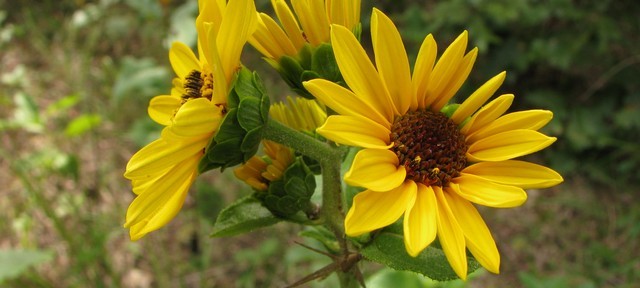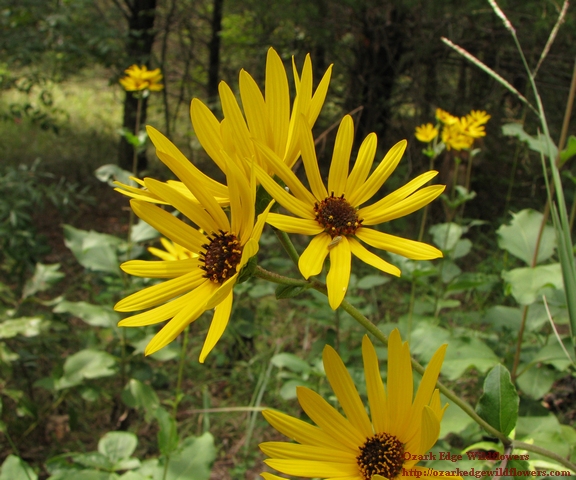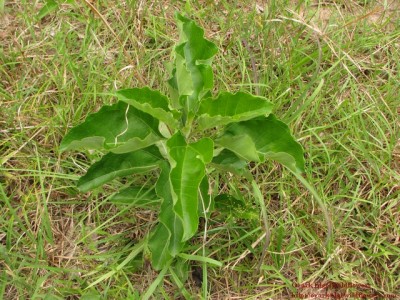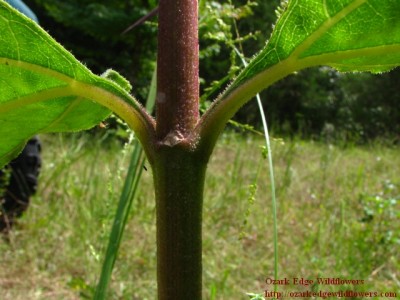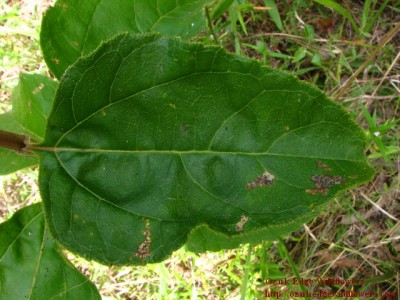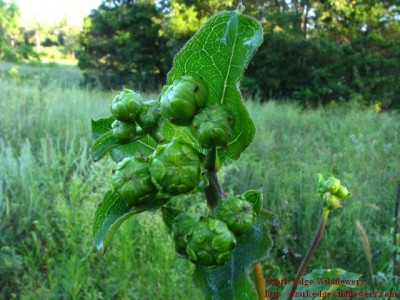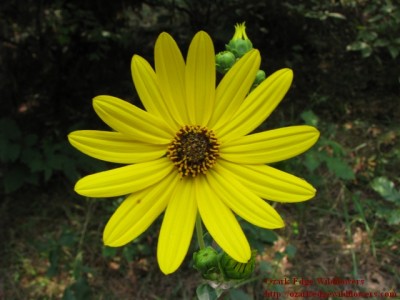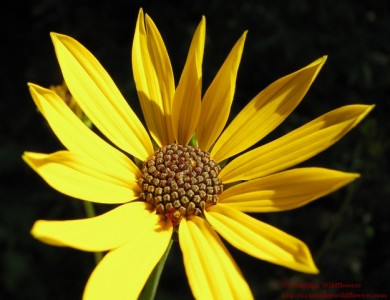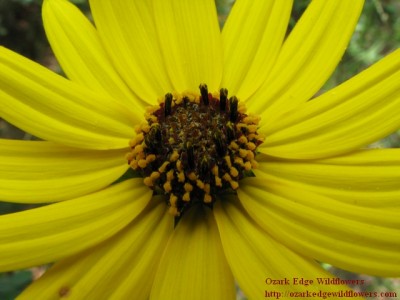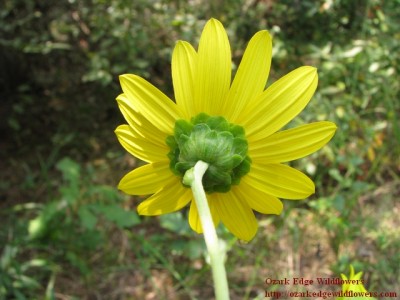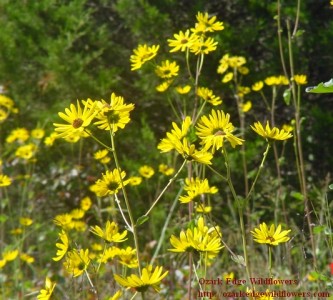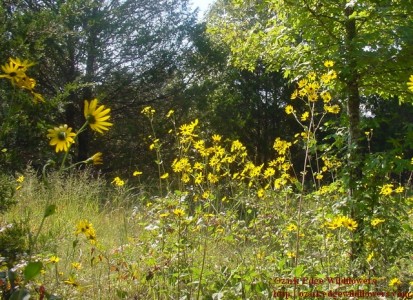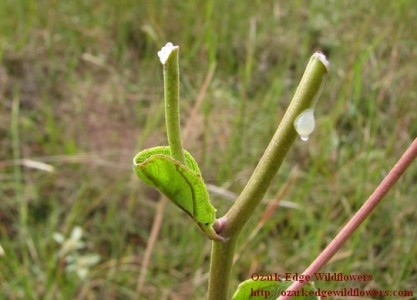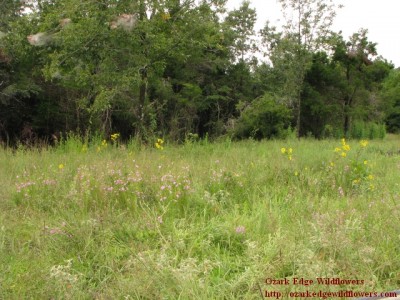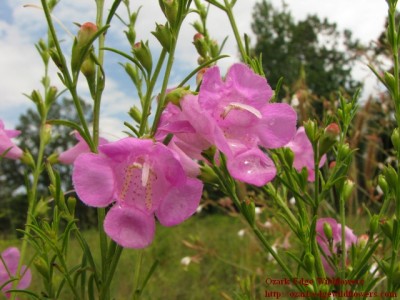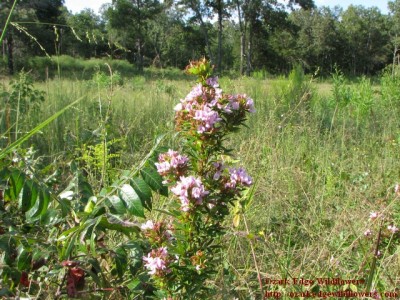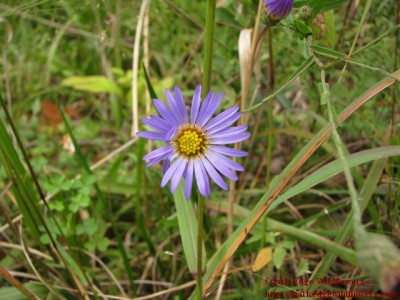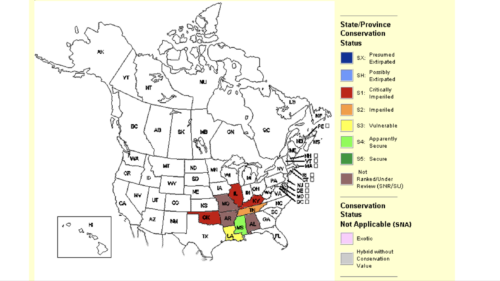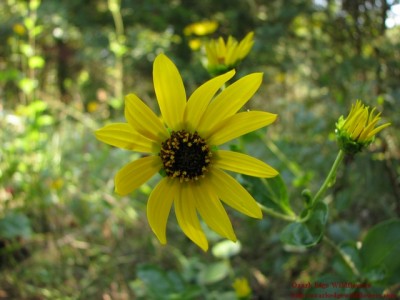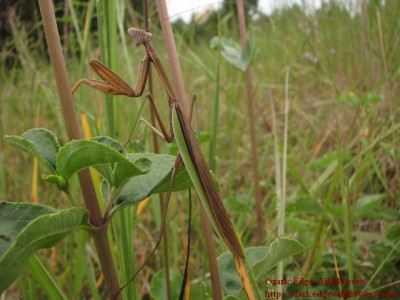Helianthus silphioides is an interesting plant. It is slow to awaken each year. On Ozarkedge, other similar plants are up and enjoying the warm sun before the basal leaves of the Ozark sunflower emerge. Once the basal leaves appear, a stalk soon follows. The quickly growing stalk seems to surpass the leaves, as they become sparse and stunted toward the top. The bloom time is shorter than the other sunflower types of plants here, but the flowers are plentiful, beautiful and worth the wait.
Latin Name/Common Name- Sunflowers are in the Asteraceae family and Helianthus genus. Helianthus is derived from the Latin “helios” (sun) and “anthos” (flower). The epithet, “silphioides” means “looks like silphium” which is another genus in the Asteraceae family. It does look a bit like another wildflower I find on Ozark Edge- Silphium integrifolium. Common names include Silphium sunflower, Rosinweed sunflower and, my favorite, Ozark sunflower. Its peak occurrence is within the Ozark mountains of Arkansas.
Bloom Color- The flower of Helianthus silphioides is butterscotch yellow with a dark, red central disk. Each plant sends up a nearly bare stem that branches numerous times toward the top to give rise to 12 or more sunflowers.
The butterscotch bloom of Helianthus silphioides
Description- This plant is not difficult to identify. The leaves are very distinctive. The lower leaves are opposite, wide at the base and large, having a somewhat oval shape. Rubbing ones hand against the leaves is similar to rubbing against sandpaper. The edges of the leaves are toothed. They have a tendency to fold longitudinally along the prominent vein. On the upper portion of the stem, the leaves become alternate, fewer and smaller.
The stem tends to have bristly hairs on the lower aspect and may be nearly hairless on the top half of the plant.
A young plant in June
The lower leaves are opposite
The leaves are wide at the base, toothed and have a blunt tip
Helianthus silphioides flower buds late August
A flower appears August 29th
The disk flowers have not yet opened
The dark red disk flowers have yellow stigmas
The flower bracts are rounded
Bloom Time- Helianthus silphioides is later to bloom than Helianthus mollis, usually waiting until late August to fully open. Peak bloom typically occurs in September and ends by early October.
Each plant can produce a profusion of flowers
Habitat- Across its limited range, Helianthus silphioides doesn’t seem to be too picky about its habitat. It is usually found at the borders of woods and is reported to prefer acid soil. It can thrive on both dry upland sites as well as wet, sandy sites. On Ozarkedge, I find it growing in a disturbed field with only partial shade as well as woodland borders. By the woodland edge, it is growing in a small colony, but solitary plants occur in the nearby fields and woods.
Habitat at the woodland edge
Deer don’t mind taking a bite of Helianthus silphioides
Seed dispersal of Helianthus silphioides is thought to be limited without human or animal intervention. The seeds are not dispersed by wind and are more likely to fall and stay under the maternal plant. Little is known about the life history of the plant. Deer and other mammals eating the achenes (one seeded fruit with thin wall) may help in dispersal. Birds may also assist in spreading the plants. Next year, I will collect and try to propagate some seeds.
What’s Growing Nearby?- In the prairie type field, I’ve found Purple false foxglove (Agalinis fasciculata), Asters, Rosin Weed (Siphiium integrifolium), and Slender bush clover (Lespedeza virginica) nearby.
Agalinis fasciculata blooms in close proximity and time with Helianthus silphioides on Ozark Edge
Close-up of beautiful Agalinis fasciculata
Lespedeza virginnia (slender bush clover) is another plant found nearby
Asters are often seen in bloom near Helianthus silphioides
Endangered List- Helianthus silphioides has a very limited range of only 9 states- Alabama, Arkansas, Illinois, Kentucky, Louisiana, Mississippi, Missouri, Oklahoma and Tennessee. Within most of these states, it is restricted to just a few counties. In Alabama, Illinois and Mississippi it is documented in only one county. Just two counties in Kentucky, and four in Louisiana list the presence of Helianthus silphioides. Oklahoma has not published a county-wide distribution. The link below will take you to the USDA plant site that shows the statewide distribution of Helianthus silphoides. http://plants.usda.gov/java/profile?symbol=HESI
The USDA plant site lists it as Endangered only in Kentucky. This does not really tell the whole story of this plants predicament. A Conservation assessment on Helianthus silphioides was performed by the USDA Forest Service in October of 2004. It shows the plant listed as G3G4. This is a global ranking. G3 indicates- Vulnerable- at moderate risk of extinction and G4 indicates- Apparently Secure: Uncommon but not rare, with some cause for long-term concern due to declines or other factors.
The Natureserve Conservation assessment provides a state status that lists it as S1 (Critically imperiled) in Kentucky, Illinois and Oklahoma. In Louisiana and Tennessee it is S2S3 (S2=Imperiled, S3= Vulnerable). It is listed as SNR (Unranked: State conservation status not yet assessed) in Alabama, Arkansas, and Missouri. The Conservation assessment can be accessed by this link.
* NatureServe. 2018. NatureServe Explorer: An online encyclopedia of life [web application]. Version 7.1. NatureServe, Arlington, Virginia. Available http://explorer.natureserve.org. (Accessed: March 9, 2019 ).
There are many potential threats to the long term viability of Helianthus silphioides. Much of its preferred habitat is being lost to pine plantations, agriculture, development and pastureland. Exotic plant species such as kudzu, Japanese honeysuckle and many others encroach on the remaining habitat. Since Helianthus silphioides is such a showy species, it has also lost ground to collection from gardening enthusiasts and seed companies who dig the plants for their own purposes.
The Ozark sunflower
Interesting Tidbits- Nearly every year I find scores of red aphids on the Helianthus silphioides. They appear suddenly when the plants bloom and literally cover the stems. I was unable to find anything about this in my research. Surrounding plants seem to be ignored by the intruders. The aphid attack doesn’t seem to adversely affect Helianthus silphioides. I assume it is part of nature’s cycle. Certainly the praying mantis I photographed below enjoyed the feast.
Red aphids covering the stem of Helianthus silphioides in September
I accidentally discovered this praying mantis enjoying the aphid feast
